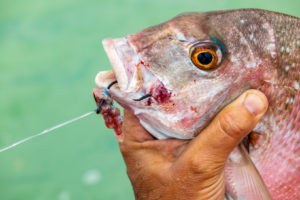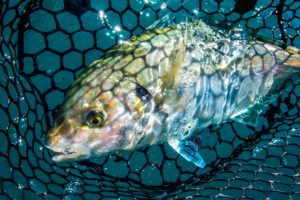Maximise the survival rate of fish released after capture
Which techniques maximise the chances of a fish’s survival upon release? Things such as how long the fish has been fought for, whether they have been lip or gut hooked, how they are unhooked and handled and if they can be returned quickly back to depth all play an important part in their survival. Once released, fish may swim away strongly and the fisher thinks they are healthy and back to normal. Unfortunately released fish can still succumb to infection and die days later from loss of slime during the handling process. Here is an important checklist to consider when out fishing.
Hooks and barbs – what you need to know

- If bait fishing, use large baits on large hooks, 7/0 or bigger. More information on hooks for bait fishing here.
- If bait fishing, inline (offset) circle hooks are best as they are less likely to gut hook fish. More information on circle hooks here.
- Crush the hook’s barb so fish can be easily released with as little handling as possible. More information on crushing your barbs here.
- Where safe and practical, release fish while they are still in the water. Using barbless hooks means fish can be flicked off the hook with a pair of pliers without touching the fish.
- Avoid using stainless steel hooks as these take a long time to rust out if a fish escapes.
Handling techniques – how to do it properly
- If a fish cannot be released in the water, use a rubber mesh net to lower the fish into the water.

- If the fish must be handled use wet hands. No towels or rags. Fabric removes the protective mucus from the fish making it susceptible to infection even if it is released in good condition.
- Do not squeeze the fish or force it against your body to remove a hook. If required, place the fish on a cool, wet surface to remove the hook prior to release.
- If you want to photograph your catch before release, work quickly to minimise the time the fish spends out of the water. Hold the fish under its chin and stomach. Avoid any contact with the fish’s gills or eyes.
- When returning a fish to the sea place it as close to the water as possible before release.
- If you must release a gut hooked fish, leave it in the water (if safe to do so) and cut the line as close as possible to the mouth. Do not try and forcibly remove the hook as this will cause undue damage to the fish.
Help your fish beat barotrauma
- If a fish is suffering from barotrauma, use a descender rig so it can depressurise and return to depth. More information on descender rigs here.
- If a descender rig is unavailable, carefully puncture the swim bladder extending from the fish’s mouth with a hook point or similar object. Do this quickly before release to help the fish return to depth. (See video above).
Take note if you are using this tackle
- If using sinkers, use rigs that allow the sinker to slide off and not be carried around by the fish. Stray line rigs with a sinker above the swivel are suitable.
- Use suitable tackle to land fish as soon as possible so released fish have maximum chances of survival.
Landbased best practices
- If land-based fishing, avoid dragging fish onto the sand or rocks prior to release.
- If land-based fishing, use a long rod (3 metres or more) to safely swing fish into waiting, wet hands before release. Larger fish can be held in a rock pool before taking a quick photograph prior to release.

Blog


